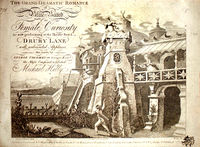Annotation:Blue Beard: Difference between revisions
No edit summary |
No edit summary |
||
| Line 3: | Line 3: | ||
<p><font face="garamond, serif" size="4"> | <p><font face="garamond, serif" size="4"> | ||
'''BLUE BEARD.''' English, Country Dance Tune (2/4 time). A Major. Standard tuning (fiddle). AABB. '''Blue Beard; or Female Curiosity''' was a pantomime produced in 1798, with music by Michael Kelly and text by George Colman, the Younger. Advertised as a "Grand Dramatick Romance" it was written as an alternative for a Christmas pantomime, accessible to children in the audience. The Royal College of Music's Virtual Exhibition (Pantomime and the Orient) explains: | '''BLUE BEARD.''' English, Country Dance Tune (2/4 time). A Major. Standard tuning (fiddle). AABB. '''Blue Beard; or Female Curiosity''' was a pantomime produced in 1798, with music by Michael Kelly and text by George Colman, the Younger. Advertised as a "Grand Dramatick Romance" it was written as an alternative for a Christmas pantomime, accessible to children in the audience. The Royal College of Music's Virtual Exhibition (Pantomime and the Orient) explains: | ||
[[File:bluebeard.jpg|200px|thumb|left|The 1798 publication of Blue Beard]] | |||
<blockquote> | <blockquote> | ||
''Scenic spectacles and rapid transitions, brought about by Harlequin’s magic wand were the stock-in-trade of'' ''pantomime, and they brought good box-office returns. Michael Kelly had seen Grétry’s opera Barbe Bleue, based on'' ''Perrault’s fairy tale, in Paris in 1790. He paid Colman to make a libretto out of it, and Colman turned the French'' ''villain into a Turkish one, Abomelique. Reviews of Blue Beard were very mixed, but the work was popular with'' ''audiences. £2000 was spent on its preparation. Its most impressive effect was a grand cavalcade across the'' ''mountains, which used model figures and animals growing larger at each successive appearance.'' [http://www.cph.rcm.ac.uk/Virtual%20Exhibitions/Music%20in%20English%20Theatre/Pages/Caption4.htm] | ''Scenic spectacles and rapid transitions, brought about by Harlequin’s magic wand were the stock-in-trade of'' ''pantomime, and they brought good box-office returns. Michael Kelly had seen Grétry’s opera Barbe Bleue, based on'' ''Perrault’s fairy tale, in Paris in 1790. He paid Colman to make a libretto out of it, and Colman turned the French'' ''villain into a Turkish one, Abomelique. Reviews of Blue Beard were very mixed, but the work was popular with'' ''audiences. £2000 was spent on its preparation. Its most impressive effect was a grand cavalcade across the'' ''mountains, which used model figures and animals growing larger at each successive appearance.'' [http://www.cph.rcm.ac.uk/Virtual%20Exhibitions/Music%20in%20English%20Theatre/Pages/Caption4.htm] | ||
Revision as of 04:58, 10 August 2012
Back to Blue Beard
BLUE BEARD. English, Country Dance Tune (2/4 time). A Major. Standard tuning (fiddle). AABB. Blue Beard; or Female Curiosity was a pantomime produced in 1798, with music by Michael Kelly and text by George Colman, the Younger. Advertised as a "Grand Dramatick Romance" it was written as an alternative for a Christmas pantomime, accessible to children in the audience. The Royal College of Music's Virtual Exhibition (Pantomime and the Orient) explains:

Scenic spectacles and rapid transitions, brought about by Harlequin’s magic wand were the stock-in-trade of pantomime, and they brought good box-office returns. Michael Kelly had seen Grétry’s opera Barbe Bleue, based on Perrault’s fairy tale, in Paris in 1790. He paid Colman to make a libretto out of it, and Colman turned the French villain into a Turkish one, Abomelique. Reviews of Blue Beard were very mixed, but the work was popular with audiences. £2000 was spent on its preparation. Its most impressive effect was a grand cavalcade across the mountains, which used model figures and animals growing larger at each successive appearance. [1]
Source for notated version:
Printed sources: T. Skillern (Twenty-Four Country Dances for the Year 1799), 1799; p. 11.
Recorded sources:
Back to Blue Beard
